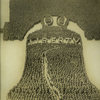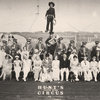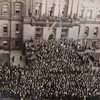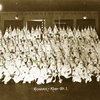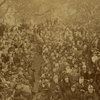A Conversation with Bill Hunt
MORE IMAGES
There is a delicious silliness to it all. I want to pack the rooms with framed photographs so that you have to work your way through an avalanche of images. Look, look, look. React!
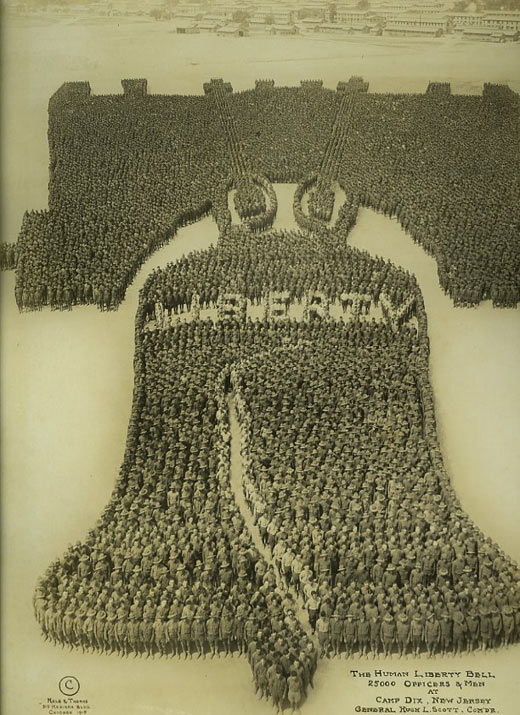
The Houston Center for Photography (HCP) is currently showing RE: groups - American Photographs Before 1950, selected from W.M. Hunt´s Collection Blind Pirate. HCP approached me about doing an interview with Bill for the current edition of SPOT Magazine, and of course I was thrilled about the idea. The outline was to produce “a 1,000 word dialogue on the subject,” and at the end of the day, we only overshot the target by 500%. The current edition of SPOT Magazine contains an abridged version of the conversation, here is the full piece. Click on the images on the side to see larger versions. (more)
Jörg Colberg: Your collection of photographs of large, often anonymous groups might come as a surprise to many who wouldn’t have expected something like this from someone who has been (in part literally) dealing (with) photography for a long time. Why these photographs? What is it that appeals to you?
Bill Hunt: It even comes as a surprise to me. Part of collecting it has been subversive so thanks for noticing that. Subversive is a word I like in art. There were a few group images in the larger, known “Collection Dancing Bear” - magical, heart stopping images of people in which the eyes cannot be seen - that were spectacularly odd: Klu Klux Klan, John Greenleaf Whittier funeral, some press prints. They have been included in the major exhibitions of the collection in Arles, Lausanne and Amsterdam. But then some oddities have crept into the collection.
There were some E.J. Kelty images, one with “HUNT CIRCUS” on the left of the image, and “BEARS” on the right, and another of Madison Square Garden filled to the rafters. I also love Mole & Thomas, their amazing formations of thousands of service men and women creating the Liberty Bell or whatever. These images may seem to fall outside the criteria of the “No Eyes” collection but I was so attracted to them that they got acquired. Collectors make rules, and then break them.
JC: All of these photos also show American groups - why only Americans?
BH: It was arbitrary initially, but then it eliminated the need to include any of those non-US totalitarian regimes.
Also there is something rambunctious about this kind of work. We deem most of this work as vernacular. It is, at the very least, a part of popular culture. I respond to its direct nature as a kind of American Folk Art.
JC: I like the idea of turning this kind of American Folk Art into something bigger - there always is this somewhat artificial distinction between “high art” and, well, the rest (whatever you want to call it); and removing that barrier, or actually showing that in principle there really is only a barrier in our minds is something I like about your collection. And this seems to tie in with how people look on places like Flickr for images - it’s like visual data mining. Your collection would indicate that such an idea is not really new, though?
BH: I try to resist categorizing. It works or it doesn’t work, no matter the intentions. There is increasing recognition for collectors as artists when they demonstrate a unique ability to gather together disparate works into a coherent grouping. The National Gallery and the Met have both done exhibitions of vernacular - snapshot - collections belonging to private individuals. Apparently Steichen did one at the Modern in the 1950’s well before the Szarkowski regime.
My collecting really has had no agenda beyond the visceral. I saw it, I liked it, and (if I could) I bought it. As a dealer, the idea of stroking the collector through a purchase was initially completely foreign to me. I have never brought any sense of investing to this either. (This is colossally ironic because the collection is probably my annuity.)
Responding to your statement, though, collectors like Andre Jammes and Sam Wagstaff loved the “stuff” in photography, not just the classic beauties. Look also at Walker Evans collection of Road Signs. Totally wild.
JC: That’s not something you see a lot in the photo world, having no agenda beyond the visceral. When you read statements, it’s so often as if photography was really about something grandiose. Has our contemporary photography world taken things too far, maybe because so much of the artists come out of brainy MFA programs where there are actually courses where all you do is to read French “postmodern” philosophy?
BH: Looking at art, being frustrated by the overwhelming number of derivative works, you become aware of how hard it must be for an artist to do something fresh. Schools keep turning out more of them. The things that they don’t teach in school are instinct and nerve.
When I have taught history classes, I try to emphasize seeing through your own eyes and to not readily accept the received gospels of say John Szarkowski, to name one. Getting juicy isn’t easy. I spent a period of time looking at “self taught/Outsider/folk art” and also “found objects”. Raw rough stuff can be much more vital and exhilarating than studied, over considered work. My line is that photography should have “de-light”.
JC: How can you teach instinct? Or nerve? I sometimes think that students mostly learn to quote the “right” references, whether they’re Roland Barthes or John Szarkowski. And isn’t the art world a bit scary in that way, given that everybody seems to constantly be referencing the usual suspects?
BH: You’re right. A reason that people are intimidated about looking at art is that they are fearful that some academic will condemn their unschooled, unworthy opinion. You can inform the way in which a person responds to art and encourage them to recognize and even to articulate their feelings. In my past there is an appropriate story I think. I was very attracted to the work of Elaine Reicheck over a period of time, and I would sit for periods of time looking at her work in a certain gallery. Her dealer complimented me on my “eye” which I took exception to because I thought he was flattering me in order to make a sale. So I bristled when he said it. He took exception to that and said didn’t I know I had an “eye”. Well, I had never thought about that. So I did … think about it and decided that maybe I did. Then I started to take a little credit for it because it turns out that a lot of people thought I had some taste and wit about pictures. The whole arc of my collecting has to do with the development of my own sense of self esteem so your question is right on the money, and I think the answer is no, it cannot be taught. But you can aspire to it and find your own way.
JC: Coming back to your collection, there seem to be some rules (or rather the collection was/is built following these rules). Did you have these rules in place before you started, or did the rules evolve along your collection?
BH: Most often I imagine that one doesn’t know they have a collection until they look at all the stuff in the room, and then they realize that it is a collection. I don’t think I consciously set out to collect. Initially I did look for a photograph of someone in which his or her eyes were covered, I found one and then I looked for another and so on. Then one day you look around the room, and you’ve got a collection.
With the “Groups” I discovered that there were more than I had imagined - enough for a show - and further that they were indeed mostly American and mostly made before the contemporary era. Once I recognized the “unconscious” rule, it became a conscious rule. Part of the reason for maintaining the cutoff date is to avoid dealing with a living artist. No offense, but I deal with artists all the time. The “RE: groups” collection gives me the latitude to work alone, in monologue as opposed to dialogue. It’s funny but recently I was showing the photographs to the photographer, Nadav Kander, and he made a comment about them that they lack tension. I recognized that I haven’t had any sort of real conversation with anyone about these pictures other than you. Houston will be a major unveiling for me.
There is a second guide point that the groups either be orderly, that the image should look like a musical score with the blacks and whites mixing in an engaging design, or that there be total chaos like ants spilling out over the ground. Either the group acts in a coordinated fashion strictly outlined by the photographer or it is a mess and the photographer must decide how to capture that.
JC: I am focusing on the collector bit so much, because I just finished reading some books on collectors and collections - amongst them Philipp Blom’s To Have And To Hold: An Intimate History Of Collectors and Collecting, Lawrence Weschler’s Mr. Wilson’s Cabinet Of Wonder: Pronged Ants, Horned Humans, Mice on Toast, and Other Marvels of Jurassic Technology, and Brett Milano’s Vinyl Junkies: Adventures in Record Collecting, and in each of the cases mentioned in those books, the collectors are usually driven by very strict rules. So the idea of collecting by simply buying what one likes is just fascinating to me. If you don’t mind, one more question about the collection itself: Do you actually look at what you have regularly? In those books, many of the collections are so huge that the collectors have no time to look at what they have - and some don’t even know what they have, they re-find stuff in their own collections occasionally. Does that happen to you?
BH: Your instinct is correct that I don’t actually look at the collection piece by piece very often, or even much at all. There is a good assortment around the apartment but do I take them down and consider them for a while? No. I do, however, play the collection through my mind’s eye all of the time. And I do look at the collection as a WHOLE. I literally stand there and think, “Wow, look at all of these pictures!”
At a walkthrough of an exhibition of the big collection, a young student asked, “Why did I have to own them?” Deathless pause. “Because then they’re mine!” It is a monument to covetousness.
Again, I stand in the middle of all of them and marvel at how strange it is to have become a collector. So much stuff. Last summer I kept having Collier Brothers fantasies that something would fall on my head.
I do have a theory about collecting that it has to do with a lack of nurturing in childhood (or a traumatic event later). I think you know Joe Baio in New York. He was a child actor, and I would offer that he might have been robbed of a certain part of his childhood. The photographs are his way of handling that.
Collecting certainly has to do with insisting on a certain order in one’s life.
I asked another client how long he had been collecting. “7 years ago … my wife died”. Heartbreaking.
Your thoughts?
JC: I actually don’t know what it is about collecting. Personally - with my various collections (a lot is probably worthless trash for other people) - I think that I’ll take the “Because then they’re mine” answer. Why do I collect old plastic pocket transistor radios even though I never even listen to the radio? I have no idea.
BH: Maybe they’re like shells and rocks? They feel good.
JC: I found an interview with Umberto Eco the other day, which might contain a bit of a clue about collecting. Talking about lists - do you have a list of your collection? - Eco said that they were both “anarchistic” and that we humans like lists “because we don’t want to die.” If the list is the “origin of culture” as Eco claims, is the - any - collection the origin of art?
BH: Lists? “The Vertigo of Lists”. I make lists of lists, and none of them ever seem to be completed. There are written lists and there are lists in my head. There are wish lists of pictures, lists of “things to do”, etc. There is a compulsiveness to that - like collecting. Periodically I resolve that there shall be no more lists, imagining some respite from neurotic tail chasing. Not finishing the lists guarantees immortality.
When I bought the open eyed Bill Brandt portrait of Dubuffet, I thought that might be the end of a list. It seems to have been the end point for the eyeless “Collection Dancing Bear”. Then I looked around and found there was this other collection of groups. One of the pleasures of an exhibition is that you actually have to send the exhibiting venue a list of what will be in the show. That is a kind of closure.
JC. So where/how do you find these photographs? Do you go to flea markets, Ebay … ?
BH: I always maintain that the photographs find me. I found a killer photograph at the Rhinebeck Antiques Fair several years ago, “The Radio City Music Hall” staff, 1939. It is unusually large with everyone from the Rockettes to the ushers. It didn’t look like much at the fair, but I framed it and “shazam!” I sold it to my neighbor and will always regret it although she may loan it for the Houston show.
I look at antique markets and some flea markets although E-bay seems to have killed that. Lots of times these photographs are in the wrong places, antique stores that have them as part of an estate. But E-bay has been a major source. I have lots of “keywords” and then I get an alert and I can look online.
Part of the growth of this collection is due to still having the collecting addiction and finding that keeping costs to a couple of hundred dollars doesn’t break the bank. I am not as obsessed with this Groups collection although it has gotten out of hand in a most remarkable way.
JC: I love that one of the rules behind this collection is that images shouldn’t cost more than a couple of hundred dollars. Over the course of your career, you have dealt with a lot of well-known artists, whose photographs sell for way more, and here you are, looking for treasures that are “worth” a couple hundred bucks at most. There has been so much talk about how the art world has ballooned into this entity unaffordable for anyone but the super-rich, and you’re showing everybody how you can create the greatest collection in completely different ways. Was this ever part of the consideration about the collection for you?
BH: Not initially but then it became of an act of subversion and cheapness.
JC: You do like subversion a bit, don’t you? Making people stop and look and maybe reconsider things?!
BH: I think about this like Diagliev’s admonition “Astonish Me!” I was in the theatre for many years and have never escaped it. My mission is to mess with people and to insist that they “see” or “consider”.
JC: Is that also what makes a successful gallerist? Insisting that people - possible clients - see or consider?
BH: Successful is relative. I do think that the best part of being a dealer is leading people to work that I find worthy and then imaging that when the work is shown it will be persuasive. That is how you build a reputation. It is so very difficult to sustain that.
JC: That’s very hard to learn - if you can learn it at all - isn’t it? What’s your secret? How do you find persuasive work to show?
BH: It is so very, very difficult. But I try to keep my eyes and ears open. I go to art fairs, I look at magazines, I judge competitions, and I socialize. Most work is through referral. Also you develop a sixth sense about looking. I am accessible with a few roadblocks in the way. I figure that if an artist manages to navigate those, it was meant to happen. Jean-Jacques Naudet of Paris Match and American Photo admonished me, “Bill, you have to look at everything”. He’s right. But you know almost instantly. If it takes a half dozen images to catch my attention, it hasn’t happened.
Listening is sometimes as good as looking. An example: I overhead two separate conversations in which a photographer was described as genius. The people confiding to friends were Kathy Ryan of The New York Times Magazine and Elizabeth Biondi of The New Yorker. How strange and compelling that I would be eavesdropping at two different moments, and the same artist’s name would come up. These ladies are at the top of their games and they do not rhetorically refer to someone as “genius”. Attention must be paid. It took some sleuthing to discover that they were talking about Horacio Salinas, who lets me describe as the “conceptual guy” at Vogue. They are totally right. He is genius. I found his phone number, called him up, and had the complete “ah hah” experience with him. I used him in a show as soon as I could. Stay tuned.
JC: Do you ever get tired of looking at photos? I hear that a lot, especially when people talk about the internet, and how - supposedly - there’s too much photography online. I don’t think that’s true, but then I’m an image junkie.
BH: Me too. It is like drugs exactly. You are always looking for that great buzz again. You begin to despair because you do look at more and more mediocre or good stuff - there is so much very good work being done- but not the great material. But when it happens, when you find the amazing photographs, it is exhilarating. My class at SVA just did a big assignment based on Bruce Bernard’s One Hundred Photographs, a collection of 100 great but unknown images. Yesterday a student included a Roger Ballen I had never seen, and it was remarkable. It broke all the rules of composition. It has the most ingenious structure, and fist on the edge of the frame, a flying/resting cat, a pile of unidentifiable fabrics. Fantastic. It made looking at homeworks for umpteen hours worthwhile.
JC: How did the idea of presenting the (groups) collection in a show emerge? It would seem like that’s the ultimate “getting out of hand”! And will you maybe present the collection in book form?
BH: The “No Eyes: Collection Dancing Bear” will be a book, The Unseen Eye, from Thames & Hudson in a year or so. With the “RE: groups” there is no plan. The Houston show came about through an invitation and then a conversation. I like it when things come together simply and immediately.
JC: Let’s maybe talk about some of the images you have. If you would have to pick just one favorite which one would that be, and why?
BH: The Klan. (“Hanover - The Klan - No. 1”). It is crazy. The idea that all of these men would assemble for a group “banquet style” photo and that some of them would forget their hoods and put dinner napkins over the faces. Mind blowing. Insisting on anonymity in a photograph that is a representational report. Where in the US was this made? Hanover … where? New Hampshire? Chilling.
JC: Did you try to find out more about the photo? Did you do some research? Do you do research on any of your finds, trying to find out whether there is a history?
BH: Not really. How? My partner insists that the Klan image is from Indiana. I am fine not knowing. If there is any sort of text in a Groups photo, I’ll “google” it to see if that uncovers some information.
JC: Devils’ Advocate: If you look at the Liberty Bell image, with its hundreds of carefully placed people, that’s in principle not all that different from images you find in totalitarian regimes, too, is it? I mean if we ignore the fact that it’s the Liberty Bell (instead of a hammer and sickle, say), they clearly needed to put quite the organizational skill into producing such an image (can you imagine having to organize that?). Maybe there IS something universal about humans loving to see such arrangements?
BH: Maybe … . It’s a thought. Is it about CONTROL?
JC: Images like the Dance Club grouping - what appeals to you in those kinds of images? There must be thousands and thousands of those around.
BH: Undoubtedly, but there is only one with my parents in it. The St Clair River Dance Club. I grew up knowing most of those people. There is a Sam Wagstaff story that the first picture he bought was a sports team photo he found at a flea market … it had his dad in it. Once upon a time with these images, someone knew all of these people. They were quite personal.
JC: Are you aware of any kind of organization within these images of groups? Are there groupings that are prevalent at different points in time, maybe reflecting the general mood or preoccupations of their time?
BH: Certain groups seem to proliferate in specific time periods with social organizations (“brotherhoods”) in the late 1890’s, military formations in the early 20th Century, occupational images in the post WW II period, schools at the turn of the century then again in the 1950’s. I don’t know what this is a function of. It behaves like fashion, and I found it odd but worth commenting on. At least that is what my shopping reveals.
JC: Maybe somewhere in your collection there is a bit of cultural history hidden? Maybe without knowing you’ve actually assembled something that can serve future cultural historians?
BH: Absolutely. These images are part of the visual social and cultural history of America.
JC: I’m also wondering whether there is some sort of additional focus, beyond the American folk imagery, maybe having to do with the kind of people in these groups? I know you said you were not actually looking at the images a lot, but now that I’ve asked you so many questions about them…
BH: I recognized (again) that one way of knowing something is to own it first then figure out what it means. For instance, I see that I am drawn to images of gatherings of non-whites. Prejudice is an awful thing. One of the difficulties with racial understanding is our failure to see the complexity of class structure. I am fascinated by images of middle class Asian and African-Americans because they seem so immediate and yet so foreign. It is not the way white people process history so it is as if they have dismissed part of the record. I don’t think I really understood or recognized that.
JC: … which brings me to one of my favourite topics, namely that the experience of art is not necessarily to “consume” something somebody else - the artist - created, but to have it work on oneself, to become a different person. Is this something that is important for you, as someone dealing with art?
BH: My favorite contemporary artists are provocateurs. They are agitators. Olafur Eliason, Vik Muniz, Anish Kapoor, Felix Gonzalez Torres - they all challenge our expectations.
JC: With the images in the collection, such as the River Dance Club, it often gets down to stories, doesn’t it? Just like in the case of the Klan photo, it makes you wonder what the stories of those people might have been. Those group settings are often a bit unusual - do you find yourself wondering about the stories, what the people might have felt? Or is that something that doesn’t interest you?
BH: I like the idea that there were reunions or rallies. There is a sense of ebullience and camaraderie in lots of them and I love that. The specifics aren’t so interesting to me though.
JC: Is that something you’re missing in the kind of photography hanging in today’s galleries? Even when there are photographs of huge crowds - Gursky comes to mind - there hardly ever seems to be any ebullience or camaraderie…
BH: Gursky’s rave is one of my favorite contemporary works and I think that is a wave of - your word - ebullience and chaos, a thrilling photograph. But it is more about form and structure than content. I do agree though that contemporary work has an overall coolness, but does anyone else do crowds - other than Spencer Tunick? I still think it must be difficult to shoot.
JC: That Gursky one is great, and it frankly escapes me why so many people just hate so much of his work. I like the Madonna concert one even better. If I have to think of another photographer, Massimo Vitali has lots of crowds. But then there’s the problem: These days, when someone sees a photo inevitably you’ll get “Oh, wait, didn’t Gursky do that already?” With your groups, one of the things that struck me is that while the images look completely natural - unlike a lot of stuff produced today so that it won’t look like what everybody else is doing - they are also very unique. It’s new imagery even though it’s pretty old actually. You must have seen a ton of images over the past decades - I can’t even imagine. Do you ever get tired of looking at images? And does looking at these photos, many of them so unposed and so “natural” provide a bit of, let’s say rest from today’s coolness?
BH: I hadn’t thought of it as visual relief but you’re right. The truth is that there is very little that surprises. These groups somehow got saved and stored and have reappeared on my radar somehow. They will be presented in Houston in a new and contemporary context as formal constructs that are also curiosities. There is a delicious silliness to it all. I want to pack the rooms with framed photographs so that you have to work your way through an avalanche of images. Look, look, look. React!
JC: It might be a tough audience, though, especially these days. We’re bombarded with images - the web and bloggers like me are to blame for a large part of this - and we’re using to moving from image to image quickly. Maybe seeing these older images will make people stop?
BH: It will. If only because there are going to be so many old brown ones. Also - I just thought of this - you look twice, first at the group, then you zoom in and scan through the individual faces. It takes time; we tend to glide by most often. It will take a slower metabolism. I was just looking at a brown one, a group of C. H & D railroad workers all of whom have on plaid shirts. It is a completely obscure to me, somewhere in Ohio at the beginning of the 20th Century. I caught myself grinning at it. When is the last time that happened to you? Grinning at photography.
JC: To spend a bit more time on making people see or consider - Can you tell how much I love this? Can you tell why I blog? - I know the gallery you’re a partner of a gallery that needs to make money - and that’s true for all galleries - but still, I’m wondering why so few galleries take the risk of staging truly unusual shows every once in a while. To make the whole scene stop and see and consider. Parr’s “Colour Before Color” was a bit like this. Will we see more of this at HASTED HUNT KRAEUTLER?
BH: Yes. Who, what, where and when and how … who knows? That “Colour” show came about because of my fascination with vintage color and real curiosity as to why it gets such short shrift in galleries (the material is hard to find is one reason). Then I was in Montreal with Sarah Hasted for a photo festival, and we ran into Martin Parr. We were all terrified of being shanghaied into some group dinner so we scrambled away. We talked about everything under the sun, and the next thing we knew we had a show. You keep talking and you keep looking and listening.
HASTED HUNT, our earlier incarnation, tried to shake the box with “Humankind” a reconsideration of the Family of Man” using photography by members of the photo agency VII and with “Contradictions in Black & White” which attempted to demonstrate the timeless and classic potential in works by contemporaries: Michael Flomen, Horacio Salinas, and Nathan Herger.
Look, look, look.
 By
By 
